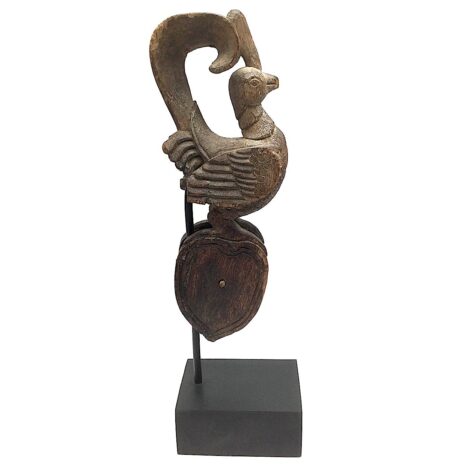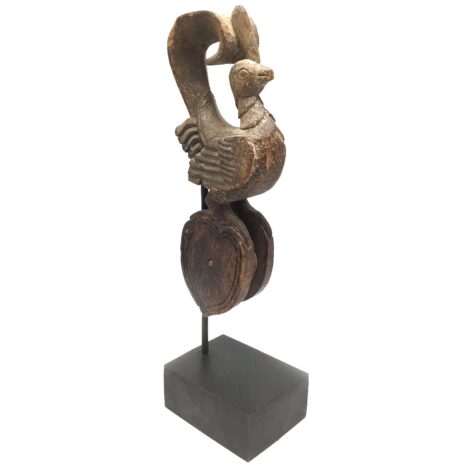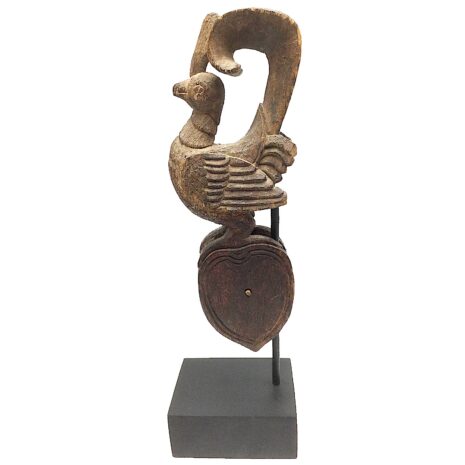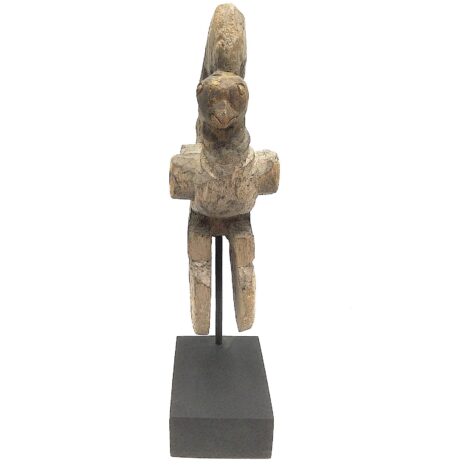Antique Hamsa Heddle Pulley, Burma/Myanmar (11298A)
Original price was: $235.00.$165.00Current price is: $165.00.
H: 10.5” W: 3.25” D: 2.375” | FREE SHIPPING WITHIN CONTINENTAL U.S.
Elegant antique heddle-pulley carved from a single piece of Burmese teak topped by a hamsa, a goose-like bird and sacred Buddhist symbol of wisdom. Auspicious symbolic animal images are believed protect the weaver, assure quality weaving, and pleases the gods and spirits. Finely weathered from time and use.
Description
Burmese carvings are known for fine craftsmanship, masterful decoration, and functional items including carved heddle pulleys used in strip-weaving. Used in pairs at the top of the loom, heddle pulleys are functional and aesthetic and usually decorated with auspicious images symbolizing figures or animals protecting the weaver, assuring good quality weaving, and pleasing the gods and spirits, an ideology from Burma’s past of animism and shamanism. This one portrays a hamsa (hintha), a mythical Burmese Buddhist goose or swan frequently used in Burmese sacred and functional folk art items. The hamsa is a sacred Buddhist symbol of wisdom and appears in the Jakata tales about the life of the Buddha, and is the Hindu god Brahma’s vahana. It can separate milk from water symbolizing wisdom and the ability to discriminate between right and wrong.
With deeply cut wings and well-articulated feathers, this hamsa has an unusually long tail curving to the top of its head. It stands atop two connected heart-shaped panels hiding the moving thimble between them that provides a more artistic feel. Using teak wood with high oil content makes woodcarvings last longer and is also less likely to crack. This piece is in very good condition, is wonderfully weathered with a fine patina covering its originally painted surface. Although there are many contemporary heddle pulleys, authentic antique used ones are increasingly difficult to find.
Click here for the blog Burmese Heddle Pulleys: Functional and Aesthetic Weaving Tools
Additional information
| Place of Origin | Burma/Myanmar |
|---|---|
| Period | Antique (1200-1920) |
| Date | Early 20th Century |
| Materials and Technique | Wood |
| Dimensions (inches) | H: 7.75” W: 3.25” D: 1.25 On stand H: 10.5” W: 3.25 D: 2.375” |
| Dimensions (metric) | H: 19.685cm W: 8.255cm D: 3.175 On stand: H: 25.527cm D: 6.032cm |
| Weight | 8 oz |
| Condition | Very good, patina and wear consistent with age and use |
| Item Number | 11298A-WCK |
| Shipping Box Size | |
| Width | 6” to 11.9” |








